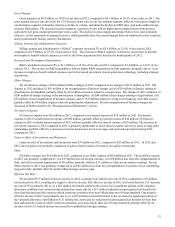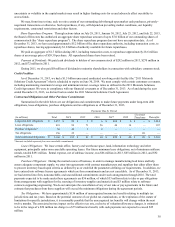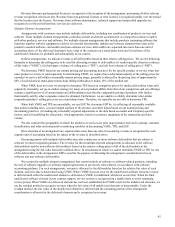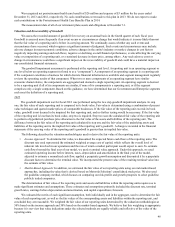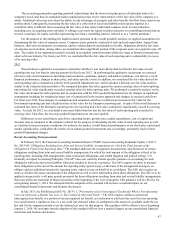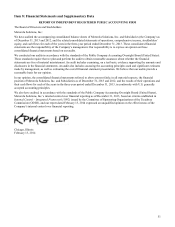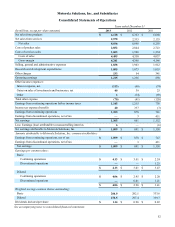Motorola 2013 Annual Report Download - page 44
Download and view the complete annual report
Please find page 44 of the 2013 Motorola annual report below. You can navigate through the pages in the report by either clicking on the pages listed below, or by using the keyword search tool below to find specific information within the annual report.42
Revenue from pre-paid perpetual licenses is recognized at the inception of the arrangement, presuming all other relevant
revenue recognition criteria are met. Revenue from non-perpetual licenses or term licenses is recognized ratably over the period
that the licensee uses the license. Revenues from software maintenance, technical support and unspecified upgrades are
recognized over the period that these services are delivered.
Multiple-Element Arrangements
Arrangements with customers may include multiple deliverables, including any combination of products, services and
software. These multiple element arrangements could also include an element accounted for as a long-term contract coupled
with other products, services and software. For multiple-element arrangements that include products containing software that
functions together with the equipment to deliver its essential functionality, undelivered software elements that relate to the
product's essential software, and undelivered non-software services, deliverables are separated into more than one unit of
accounting when: (i) the delivered element(s) have value to the customer on a stand-alone basis and (ii) delivery of the
undelivered element(s) is probable and substantially in our control.
In these arrangements, we allocate revenue to all deliverables based on their relative selling prices. We use the following
hierarchy to determine the selling price to be used for allocating revenue to deliverables: (i) vendor-specific objective evidence
of fair value (“VSOE”), (ii) third-party evidence of selling price (“TPE”), and (iii) best estimate of selling price (“ESP”).
We determine VSOE based on our normal pricing and discounting practices for the specific product or service when that
same product or service is sold separately. In determining VSOE, we require that a substantial majority of the selling prices for
a product or service fall within a reasonably narrow pricing range, generally evidenced by the pricing rates of approximately
80% of such historical stand-alone transactions falling within plus or minus 15% of the median rate.
When VSOE does not exist, we attempt to determine TPE based on competitor prices for similar deliverables when sold
separately. Generally, our go-to-market strategy for many of our products differs from that of our competitors and our offerings
contain a significant level of customization and differentiation such that the comparable pricing of products with similar
functionality sold by other companies cannot be obtained. Furthermore, we are unable to reliably determine what similar
competitor products’ selling prices are on a stand-alone basis. Therefore, we typically are not able to determine TPE.
When both VSOE and TPE are unavailable, we use ESP. We determine ESP by: (i) collecting all reasonably available
data points including sales, cost and margin analysis of the product, and other inputs based on our normal pricing and
discounting practices, (ii) making any reasonably required adjustments to the data based on market and Company-specific
factors, and (iii) stratifying the data points, when appropriate, based on customer, magnitude of the transaction and sales
volume.
We also consider the geographies in which the products or services are sold, major product and service groups, customer
classification, and other environmental or marketing variables in determining VSOE, TPE, and ESP.
Once elements of an arrangement are separated into more than one unit of accounting, revenue is recognized for each
separate unit of accounting based on the nature of the revenue as described above.
Our arrangements with multiple deliverables may also contain one or more software deliverables that are subject to
software revenue recognition guidance. The revenue for these multiple-element arrangements is allocated to the software
deliverable(s) and the non-software deliverable(s) based on the relative selling prices of all of the deliverables in the
arrangement using the fair value hierarchy outlined above. In circumstances where we cannot determine VSOE or TPE for any
of the deliverables in the arrangement, ESP is used for the purpose of allocating the arrangement consideration between
software and non-software deliverables.
We account for multiple-element arrangements that consist entirely of software or software-related products, including
the sale of software upgrades or software support agreements to previously sold software, in accordance with software
accounting guidance. For such arrangements, revenue is allocated to the deliverables based on the relative fair value of each
element, and fair value is determined using VSOE. Where VSOE does not exist for the undelivered software element, revenue
is deferred until either the undelivered element is delivered or VSOE is established, whichever occurs first. When the final
undelivered software element is post contract support, service revenue is recognized on a ratable basis over the remaining
service period. When VSOE of a delivered element has not been established, but VSOE exists for the undelivered elements, we
use the residual method to recognize revenue when the fair value of all undelivered elements is determinable. Under the
residual method, the fair value of the undelivered elements is deferred and the remaining portion of the arrangement
consideration is allocated to the delivered elements and is recognized as revenue.


